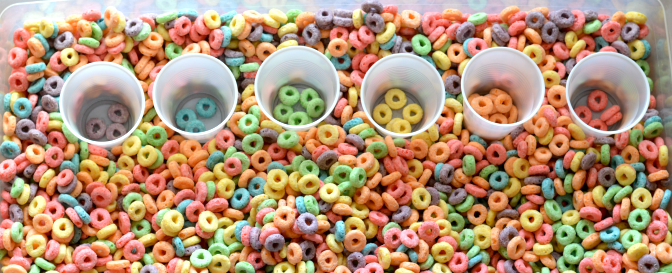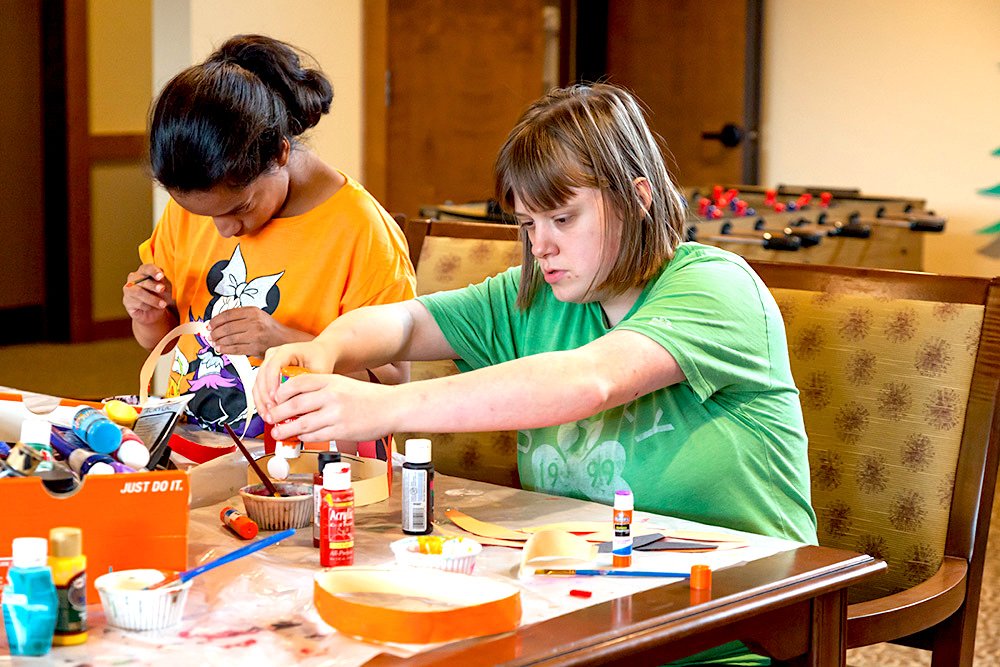5 Colorful Sensory Activities for Adult Learners
Sensory activities can encourage social, cognitive, physical, and linguistic development. For people with autism, ADD, ADHD, and other intellectual and developmental disabilities sensory can offer a lot of benefits. Sensory activities stimulate the brain, creating neural pathways and improving sensory processing systems, help improve social skills, have a calming effect, improve coordination, and improve motor skills.
At Stephen’s Place, we provide opportunities for our residents to participate in sensory and other educational activities both indoors and outdoors. As it’s currently springtime here in the beautiful Pacific Northwest, we’ll be balancing our outdoor activities with lots of indoor activities, particularly on those cooler days.

1. Edible Rainbow Sensory Bin
You will need:
- 1-2 family-size boxes of Froot Loops
- A container to be used as a bin. Plastic storage boxes work a treat!
- 1 large bowl
- 6 regular bowls
- 2-3 scoops or measuring cups for playtime
How to:
Empty your Froot Loops into your large bowl (you can also use the sensory bin, but a separate bowl is easier). Sort the Froot Loops by color into the regular-size bowls. When they’re all separated, gently lay them out one-by-one into the sensory bin. If you want a true rainbow, the pattern is red - orange - yellow - green - blue - purple.

2. Colorful Sensory Bags
You will need:
- Ziplock bags
- Acrylic paint in 5-6 different colors (preferably washable)
- Coconut oil (or any cooking oil)
- Painters tape
- A small square of bubble wrap (optional)
- A piece of aluminum foil (optional)
How to:
Pick 3-4 paint colors per bag. Give one good squeeze of each color into the Ziplock bag of choice (make sure that the colors are next to each other). Add a tablespoon of oil to the bag. Gently squeeze out the air without mixing the paint too much. Seal the bag, fold the sealed edge over and tape it with painters tape. Squish away! If you’d like see-through sensory bags, you can use hair gel and food coloring instead of paint and oil.
3. Rock Painting
You will need:
- To take a stroll and find a few smooth rocks
- Acrylic paint in 3+ colors
- Art paintbrushes
- Acrylic varnish to seal
How to:
Paint your masterpiece however you want! If you like the design, seal it with the varnish. You can use these as paperweights or as colorful additions to the garden.

4. Rainbow Moon Sand
You will need:
- 3 cups of flour
- 12 tablespoons of canola oil
- Red, orange, yellow, green, purple, and blue food coloring
- 6 bowls
How to:
For each color, mix 1/2 cup of flour with 2 tablespoons of canola oil and add a few drops of the desired color. If your food coloring pack only has the primary colors; red, yellow, and blue, you can use them to create the secondary colors; purple, green, and orange. For purple, you can mix red and blue together, for orange you can use a mix of red and yellow, and for green, you can mix blue and yellow together.
5. Gelatin Sensory Tub
You will need:
- Red, orange, yellow, green, purple, and blue Jello
- A plastic washing-up bowl or another mid-size container to be used as the sensory tub
- 6 regular bowls or Tupperware containers
- 2-3 scoops or measuring cups for playtime
How to:
Prep your Jello as per the instructions on the pack. Prep each color in a separate bowl. Let set overnight. Once set, keep each Jello in its own container and cut into chunks. Gently lay them out one-by-one into the sensory bin. If you want a rainbow, the pattern is red - orange - yellow - green - blue - purple.
About Stephen’s Place
Stephen’s Place is an independent apartment community for adults with developmental and intellectual disabilities, located in Vancouver, WA (7 minutes from Portland, OR).
If you have a loved one with developmental or intellectual disabilities, who is looking for a community to live in, please contact us for more information. Stephen’s Place is a private-pay apartment community due to our state-of-the-art amenities and programs. We are a nonprofit and do not profit from our community. We are private pay because we spend more than some housing communities to ensure that our residents are comfortable and can safely live their lives with independence and dignity.

